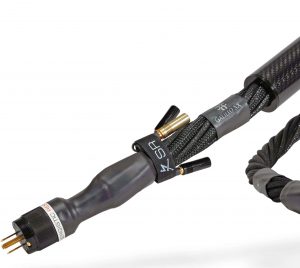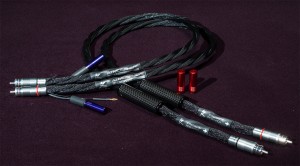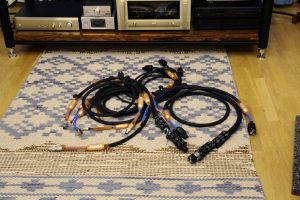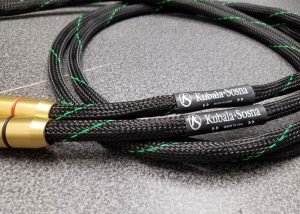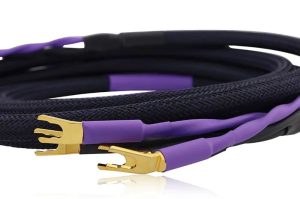.JPG)
It must be a real shock for a company that uses some particular material as a key element for its products when it learns that it won't be manufactured anymore by a single provider. If the whole philosophy of a company, which means its all activity, is based on this single element/material the end of its production/availability might mean the end of this company. It's like to tell a painter that he won't be able to buy his favorite paint, shade or whatever he likes to use to create his art. Trauma!
In audio industry something similar could happen to many manufacturers if Philips decided to stop producing Compact Disc CD-Pro2LF transport mechanism, or some manufacturer stopped making some top quality capacitors used in crossovers of top high end speakers.
The only thing left to do, assuming that a company wants to keep its business, is to get to work to find new solution. In this particular case of a cable manufacturer such a situation means a huge investment in everlasting trials to find a new material that will allow company to offer to customers a sound still the same in sonic character, and at least equal, or even better in terms of sound quality.
Another problem is creating a whole new philosophy. In case of Oyaide, and some other Japanese manufacturers like Acoustic Revive for example, the end of production of PCOCC-A wires meant only one of two things, the end of these companies or a new beginning (on March the 4th 2013, a year before its 130th anniversary, Furukawa Electric announced the end of production of PCOCC wires; more about this story HERE).
Satoru Murayama, the general manager of Oyaide Elec. Co., Ltd., chose a new beginning for his company. Oyaide started a cooperation with a Japanese manufacturer of cables and conductors, company Sanshu Electric Wire Company to develop a new kind of wires called Oyaide 102 SSC. Mr Murayama will tell you a story of this new conductor himself.
A few simple words…
SATORU MURAYAMA
Oyaide Elec. Co., Ltd. | CEO
CREATING THE ULTIMATE COPPER:
Oyaide New 102 SSC Conductor:
For many years, we produced our cable masterpieces using a very high quality material made by Furukawa Electric Group called PCOCC-A. It was the basis of most Oyaide cable products and, for us, a source of pride that they were 100% Made in Japan. However, at the beginning of 2013, Furukawa suddenly announced the discontinuation of PCOCC-A. This announcement was earth-shattering news not only for Oyaide, but also for manufacturers worldwide who had come to rely on the high value and dependable performance of PCOCC-A.
After deep contemplation of the available options, many of which required unacceptable compromises, we decided that the best course of action was to make our own proprietary, brand new conductor. Taking on this immense challenge is a reflection of the spirit we bring to our creations - to constantly strive to make them the best they can possibly be, while offering the highest value and performance to our customers. With this philosophy in mind, we invested over a year and a half of research and development into our new revolutionary conductor – 102 SSC.
We began our journey by digging deeply to define the new concept. We decided that the right approach would be to "produce copper of the highest quality ever made using the most advanced technologies available that would be available without interruption." The advantages of developing our own custom conductor are many. Previously we relied on available materials such as PCOCC-A and LC-OFC, but we realized that given the changing social situation, the small size of the Hi Fi Audio market and the inefficiency and uncertainty of relying on others' for critical materials, we needed to create our own "super" copper using more commonly available copper as a base material to insure a long term stable supply. It also allows us to maintain our 100% Made in Japan signature. Finally, by investing in the time and research to produce our own conductor, we have complete control of every aspect of design, quality and ultimate sonic performance. 102 SSC will allow us to further extend our technological lead in the Hi-Fi market.
The copper base material for 102 SSC is refined in Japan and conforms to the elite Japanese JIS C1011 industrial standard. Compared to other JIS C1011 coppers, we specified only pure virgin copper that does not contain any recycled material. This eliminates any chance of legacy contamination and impurities. While acceptable performance can be achieved with recycled copper, the extra effort required for using virgin copper produces not only a superior product but also a degree of pride, which comes from knowing we are using the purest possible approach. Even though assay testing reveals no quantitative difference between pure virgin and recycled C1011 copper, we felt that even the remotest possibility of contamination was unacceptable. Our aim is always to achieve the maximum possible performance and never to settle for "good enough".
Our virgin copper base material is delivered to one of Japan's most advanced wire drawing facilities where it is first rolled into a rod and then brought to a fineness of about 1mm in numerous stages to minimize stress and deterioration of the crystal structure of the copper. In typical copper wire drawing processes, impurities are removed by acid cleaning (pickling). However, the cleaning liquid tends to leave a residue, which affects performance and does not succeed in completely removing all impurities. For our 102 SSC copper, we have instead employed mechanical peeling – a very precisely controlled process that removes 100% of impurities. Our use of this more costly process, rarely seen in audio cable production, demonstrates our commitment to bring you products of the highest possible quality.
After mechanical peeling, the wire is annealed to remove all stresses and strains induced by the drawing process. A great deal of skill and dedication went into determining the exact time and temperature specifications required to maintain maximum mechanical strength, highest electrical conductivity, and optimal recrystallization. Commonly used bell type annealing leaves a residue of soot. To avoid this, we adopted 'in-line' electric annealing. Test results after this process, show an incredible conductivity level of 102.3 % IACS. This result is the namesake for 102 SSC.
.JPG)
After numerous inspections, the annealed copper wire is vacuum packed to prevent any oxidation. It must then be shipped immediately to the fine drawing and stranding facility. We specify that this must occur within two days. It is rare to impose such a strict timetable on shipment of bare copper wire, but we have done so to prevent degradation of the conductor surface. We schedule the process of fine drawing to occur within two days of arrival for the same reason. As a result, our conductor is guaranteed to remain preserved in its purest form between the different stages of development.
The standard of precision that we at Oyaide are attempting to achieve may be seen to be beyond all common sense. Our vision was to create a conductor that transcended standard technology and entered the realm of art—a conductor whose quality could be compared in its field with the likes Patek Philippe and Vacheron Constantin in theirs. Key to achieving this was our focus on the basic theory that "most electrical signal travels through the conductor's surface." To achieve the quality we sought, we knew that that the facility conducting the fine wire drawing would have to be best in the world. To this end, we engaged Sanshu Electric Wire Company in Aichi Prefecture. Without their highly skilled artisans and their commitment to pushing the limits of what is technologically possible 102 SSC would not have been born.
.JPG)
Following the success of our FTVS-510 and FTVS-910 pure silver wires, we imagined applying a similar approach to our new copper wire. Drawing by means of natural diamond dies and use of the 'skin pass process' imparts a mirror like finish to our silver wires. (Even though the wire is annealed in an inert gas, some minuscule amount of oxidation remains. Perfect surface dies are used to skim away all traces of oxidation.) We already understood through extensive testing that this level of surface perfection directly results in pure transmission of extremely high frequencies used in digital audio signals but also contributes to perfectly balanced analogue sound signals. Lack of homogeneity of the wire surface will give rise to high frequency noise which in turn reflects negatively on signal to noise ratio and playback accuracy. By applying the 'skin pass process', a high degree of surface uniformity over the entire length of wire is achieved.
In our collaboration with Sanshu Electric Wire Company, we embarked on a quest to improve machining accuracy and the polishing process. Dies normally used in drawing wire are made from synthetic diamonds for cost and efficiency. We adopted the use of natural diamond dies which are far more costly, but which yield more uniform volume reduction with reduced stress and improved lubricity. With natural diamond dies, we can set targets of ± 1μm for the outer diameter tolerance of the wire. This is an incredibly precise specification among wire producers. The adoption of natural diamond dies, and associated technologies to achieve this level of precision in outer diameter are the result of Sanshu Electric's many years of experience. They are able to monitor tolerances 1600 times per second over the entire length of a single line of wire.
Natural diamond dies are very delicate and require constant maintenance. The inner hole of each die is polished after each operation with diamond powders of less than 1μm. The 102 SSC dedicated dies all have strict maximum limits for time-hours and the distance/length during continuous run. Before being set in place, dies are always checked for wear, cracking and chipping by microscope. If there is any problem whatsoever, they will be replaced immediately. The frequency of replacement is 10 to 20 times that of normal dies, but this is necessary to achieve the level of quality we require. In this way we have created a copper wire whose surface structure is far superior to all others. With our outer diameter accuracy of ± 1μm far exceeding the ± 8μm in JIS C 3102 standards for conventional copper wires, we decided to call our process Special Surface Copper. Thus our special copper, with the world's finest surface, quality is called 102 SSC.
For the final annealing process, to remove stresses induced by fine drawing, custom annealing methods, including optimal time and temperature settings for each diameter of wire produced, were chosen based upon extensive experiments and study. Our long journey to create a new conductor is nearing its end.
The final determining factor in designing our new wire is determining the stranding method. At Oyaide, we have adopted many types of wire stranding and cable structures depending on the product type. These include: bunched stranding, concentric stranding, uni-lay stranding, rope lay stranding, cylindrical structure and solid core. We engaged Sanshu Electric's artisan craftsmen to further reflect on our established methods and together we developed a new, higher-spec technology.
For the first time in history, 3E (3 Element) stranding, developed and patented by Sanshu Electric Wire, has been adopted for an audio cable. 3E stranding combines strands of three different diameters to increase the density of the wire by decreasing the spaces between strands. This difficult to achieve stranding is only possible by means of Sanshu Electric's severe production controls. No other company in the world possesses the skill set required to achieve perfect lay 3E stranding. The result is a conductor with a smaller outer diameter than the same gauge wire made with identical individual strands, plus a more accurate, stable and perfectly circular cross section with uniform strength and super high audio performance characteristics throughout the entire cable production.
The extreme care taken in the stranding process is another example of Oyaide's commitment to excellence, to delivering the highest level of Japanese craftsmanship with pride. Sanshu Electric Wire's collaboration was essential to the creation of the 102 SSC conductor. By applying extreme focus and deep insight, and by our willingness to depart from common practices we were able to produce an entirely new class of copper.
.JPG)
We have received a few cables for a review. I wanted to find out how this new kind of copper behaves in a system—using cables from one manufacturer for all connections in the whole system makes a lot of sense since it allows us to maintain the same tonal character throughout. So I decided to use RCA interconnect Across 750 RR V2, a speaker cable Tunami II SP-B V2 and a power cable Tunami GPX-R V2 in a single test.
I compared them with my reference cables, i.e. Siltech Royal Signature Series Double Crown Empress IC, Tara Labs Omega Onyx SC and Acrolink Mexcel 7N-PC9500 PC.
But not only with them. Oyaide wasn't the only company affected by a Furukawa decision to cease production of PCOCC-A wires. Another one was also Acoustic Revive. The owner of the latter decided to use PC-triple C copper (Pure Copper-Continuous Crystal Construction) for the new generation of his products. It was definitely a positive change, as you can read HERE. So I compared new Oyaide cables also to the new Acoustic Revive products. Below you will find a description of my tests.
SOUND
Recordings used during test (a selection):
• Abraxas, 99, Metal Mind Records MMP CD 0102, CD (1999).
• Abraxas, 99, Metal Mind Records/Art Muza JK2011CD07, gold-CD (1999/2011).
• Aquavoice, Nocturne, Zoharum Release ZOHAR 077-2, CD (2014).
• J.S. Bach, English Suites 1, 3 & 5, perf. Piotr Anderszewski, Warner Classics/Warner Music Japan WPCS -12882, CD (2014).
• Leonard Cohen, Popular Problems, Sony Music Labels SICP-4329, CD (2014); review HERE.
• Sonatas op. 109, 110 and 111, piano: Evgeni Korolov, Tacet 208, "The Koroliov Series Vol. XVI", CD (2014).
• Pet Shop Boys, PopArt: Pet Shop Boys – The Hits , Parlophone/Toshiba-EMI TOCP-66252-54, 3 x CCD (2003).
• Porcupine Tree, The Incident, Roadrunner Records/WHD Entertainment IECP-10198, 2 x HiQualityCD (2009).
• Queen, Queen Forever, Virgin/Universal Music LLC (Japan) UICY-15347/8, 2 x SHM-CD (2014).
• Sting, All This Time, A&M Records 212354-2, SP CD (1991).
• Voice Factory, Voice Factory Sings Chopin a Capella, Voice Factory, CD (2014).
.JPG)
ACROSS 750 RR V2 + TUNAMI II SP-B V2
Interconnect with speaker cable create a unique pair. I believe I was the first reviewer in Europe who listened years ago to the first versions of Tunami and Across cables and I still remember how well they sounded, how nicely they filled in the whole range without attenuating any part of it. It was a combination of features that in my private book defined a sound of Japanese cables for a long time. My assessment was only confirmed each time I reviewed other brands of Japanese cables.
Although truly devoted to "vintage" products, truly conservative deep in their hearts, Japanese keep searching for new solutions, for advancements. Even if they are forced to look for something new, like cable manufacturers in this case, they try to develop a new final, or finished product, rather than something that is average or just good, to use it until they develop final product. This new, final product should offer, obviously, a better performance than a previous one, and not just different.
The best example of these efforts are Across 750 RR Vv2 interconnect and Tunami II SP-B V2 speaker cable. Their tonal balance, especially the one of IC, was surprisingly similar to that, of Siltech Double Crown cables. It is a different level of performance, that is hopefully obvious, but the tonal balance, the way it "shapes" the sound, is very similar. It's just like a search for best possible conductivity was a main goal of Mr Murayama, just as it was for Edwin van der Kley-Rijnveld of Siltech and his silver-gold cables.
A sound of new Oyaide cables is very rich and dense. Both sound range extremes are slightly rolled off, although it is not that obvious when one just listens to the music. But when one knows what to look for, one will find that out in every recording. A part of the treble seems slightly emphasized. Not much, just a bit so that phantom images seem more distinct, presented closer to the listener. This is a small modification of the sound and it is related also to the lower part of the range. Whatever happens in the back of the soundstage is presented a bit closer, not much closer, but still—that creates closer, more palpable picture. I can easily imagine that in many systems, for many music fan this type of presentation will be exactly a fulfillment of their expectations and needs.
The same can be said about lower part of the range. The very bottom is not particularly powerful—I mean the lowest bass below 50Hz. Everything above is on other hand very energetic which makes this slight deficiency below 50Hz almost irrelevant. Even my Harbeth M40.1 speakers, with their big woofer, still delivered powerful, rich bass with Oyaide in the system. Only when it came to electronic music, with truly low bass, one could tell that the lowest notes were not as audible as usually. One important remark: that was true when compared to my reference Siltech Double Crown and Tara Labs Omega combination! Most cables behave exactly as Oyaide does, only the best ones (much more expensive ones) offer more. And yet, Japanese cables offer sort of compensation for this small deficiency with its very energetic presentation of bass range that starts right above this lowest part.
Bass is also very resolving. Leading edge seems exactly as it should be—not too "edgy" and not too "soft", and it has nothing to do with a very good clarity of multi-layered soundstage, nor clarity of sounds themselves. Comparing with my reference cables Oyaide did not offer as tuneful, as three-dimensional images. But the moment one takes prices of Japanese cables into consideration their performance becomes absolutely, incredibly good.
.JPG)
TUNAMI GPX-R V2
At the first sight the difference between old and new version of GPX-R is not significant. I don't know how, but Oyaide managed to keep a general sonic character of the older version. It makes it possible to combine old and new cables in one system—I checked and they worked fine together.
At the same time there are some differences, some accents that V2 puts in different places, which, the longer we listen to it, the more important they become. The most important one is a different sort of presentation. The older version focuses on everything in the foreground. It is still quite resolving but sometimes, in some systems, this might be perceived as a sort of unwanted aggressiveness. It's not a matter of an inherent feature of this cable but rather its interaction with some systems, although the cable itself might provoke such behavior of the system.
V2 puts a bigger distance between listener and the foreground of the soundstage, it shows more space around instruments, more "air". At first one might perceive this type of presentation as less palpable, less "essential" (which I personally don't like). But after a while one realizes that this is actually a more sophisticated presentation. Yes, phantom images are not as big as with GPX-R. But that's the way it is—you get something, you loose something. But the sound is also smoother, with better balanced tonality, no emphasis in the midrange nor in the treble. Both range extremes seem not that energetic but it's a good thing here. It ensures a proper tonal balance.
GPX-R V2 offers better performance. It's more sophisticated, smoother, even silky. GPX-R's advantage is richer, more essential imaging. So I can understand why some might still choose the older version. But it is still worth to to give the V2 a chance to find out what direction Oyaide took after this (for them) huge change
DESIGN
OYAIDE ACROSS750 RR V2| 1m | RCA
.JPG)
This interconnect inherits the concept of the original Across 750, that was introduced to the market in 2007. Since then over 10 000 m of this cable was sold. While the name of the model is almost the same V2 is entirely new design.
It's a coaxial cable, with a single central conductor with a shielding around it. This central conductor is a multi-stranded wire structure of 102 SSC copper, with wires of different diameter—the idea was to get as much conductor into as small space as possible. Wires are braided together by a special machine in a process called "3 E twisted". Each strand combines wires of three diameters.
A design of this cable uses also C.I.S. (Cross Insulated Structure) structure, that allows to eliminate vibration using proper materials and a layer of air. Shielding is made of the same copper—it sports 100 wires of 0,18 mm diameter.
Using experience form older model also this time company decided to use a polyolefin, a special polymer, as a dielectric. A color of external jacket was not chosen randomly—it is called "Beluga Caviar" (yes, like the most famous caviar). Cable employs a halogen-free sheath.
Cable uses brass, rhodium plated connectors, conductors are soldered with a special audio grade, lead-less solder called SS-47.
OYAIDE TUNAMI II SP-B V2 | 2x3m
.JPG)
Also the speaker cable was built using 102 SSC copper. The same cable might also be used as power cable, and that is why, according to specification, it can endure a maximum voltage of 600 V and a current of 30 A. It is build of three identical, shielded strands. Two of them conduct signal, the third is connected to the shielding. Each strand consists of wires of different diameter braided together in a 1.15 times tighter way. A polymer, polyolefin, is used as dielectric. Conductors are enwraped with a conductive carbon tape and copper foil. Cable is terminated with proprietary Oyaide SRBN banana plugs made of phosphor bronze bar, finished with silver (internal) and rhodium (external) plating.
TUNAMI GPX-R V2 | 1.8m
.JPG)
Oyaide for its power cables used the same cable as for its speaker cables. They terminated PC cables with custom designed plugs manufactured for them by company Nicoon. Model GPX-R sports plug P/C-004 Special Edition, with special cover called "Aspirin Snow White". These plugs are made of beryllium copper, plated with combination of platinum and palladium.
Price (at the time of the review):
ACROSS 750 RR V2: 890 PLN
TUNAMI II SP-B V2 2x2.5m: 3.190 PLN
TUNAMI GPX-R V2 1.8m: 2.790 PLN
OYAIDE ELEC. CO., LTD
1-9-6 Yushima Bunkyo-ku | Tokyo
113-0034 | JAPAN
[email protected]
www.oyaide.com
MADE IN JAPAN
Product delivered for test by:
MuSon Project, Inc. | [email protected]
Article translation by Marek Dyba










